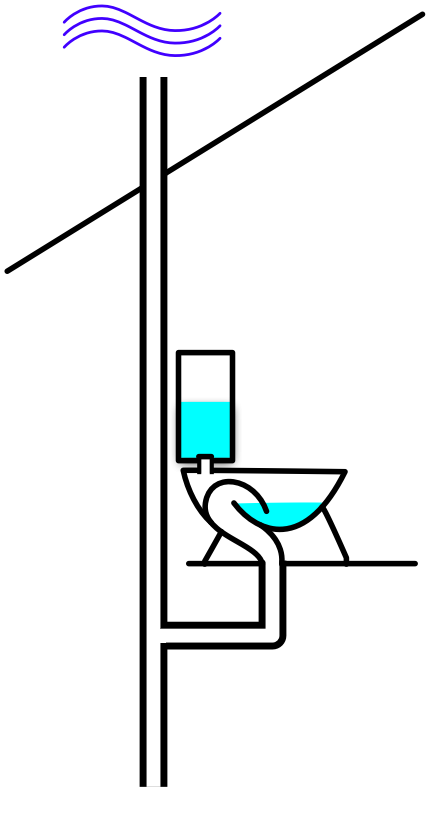Daniel Bernoulli is in your toilet
February 1, 2011 at 11:55 PM by Dr. Drang
With the Chicagoland Snowpocalype ’11 in full swing, and the wind howling outside my window, my thoughts have turned to the effect of Bernoulli’s principle on my toilet.
Wind is so strong the water in the toilet bowls is rising and falling from the pressure changes in the vent pipe. #yesimanengineer
Bernoulli’s principle comes to us via the great 18th century mathematician Daniel Bernoulli, one of the many mathematical Bernoullis who populated the academies of Europe for generations. It’s usually presented as an equation relating the pressure, velocity, and elevation of a fluid at a given point:
where
- is the pressure at the point,
- is the density of the fluid,
- is the acceleration of gravity,
- is the velocity of the fluid at the point, and
- is the elevation of the point.
(Before we go much further, let’s recall that a fluid is a substance that has no fixed shape—both gases and liquids are fluids. We’ll be applying Bernoulli’s principle to air.)
Bernoulli’s principle is probably best thought of as an energy relationship. The total energy is the sum of the pressure, velocity, and elevation terms. The total energy along streamline is constant, but how it’s distributed among the three terms can change.
For a gust of wind traveling parallel to the ground, the elevation term is constant; in this situation, Bernoulli’s principle becomes a relationship between pressure and velocity. The higher the velocity, the lower the pressure.
This may seem counterintuitive. After all, don’t high winds produce high pressures? That’s certainly how it feels when you’re standing out in a windstorm. Recognize, though, that when the wind hits you its velocity at the contact point is zero. All the energy that was being carried in the velocity term is converted to pressure, and that’s what’s trying to knock you over.
So what does this have to do with toilets? Here’s a simplified diagram of a toilet, a vent pipe, and a sewer pipe.

The vent pipe sticks up through the roof of the house to allow sewer gases to escape. The water in the bowl covers the toilet’s internal connection to the sewer pipe to keep the gases out of the living space. The water forms a kind of seal, separating the air in the vent pipe from the air in your house.
Normally, the air pressure in the vent pipe and the air pressure in the house are about the same. But in a windstorm with strong gusts, the velocity of the air passing over the vent pipe is continually changing. By Bernoulli’s principle, when there’s a big gust, the pressure in the air just above the vent pipe drops. This leads to a lower pressure in the vent pipe itself, and when the pressure in the vent pipe is lower than the air pressure in the house, the water in the visible portion of the toilet bowl lowers to compensate for the difference.
You’d never notice the lowering if the wind stayed at a constant speed, but it doesn’t. High winds tend to fluctuate rapidly, which leads to rapid changes in the vent pipe pressure and, therefore, rapid changes in the water level in your toilet bowl. The changes aren’t large but they’re noticeable because they cause the surface of the water to undulate.
You may have seen this and never realized the cause. You may have thought the water was moving because you’d somehow bumped the toilet or stepped heavily and caused the bathroom floor to shake. You may have thought it was Moaning Myrtle. But no, it’s the author of Hydrodynamica showing you one of his discoveries.


